Distributed Cooperative Optimal Operation of Multiple Virtual Power Plants Based on Multi-Stage Robust Optimization
Abstract
1. Introduction
- A deterministic cooperative optimal operation model of multiple VPPs is established to effectively coordinate the interests of each VPP;
- The MSRO method is explored to deal with the source-load uncertainties of VPPs, and a cooperative optimal operation model of multiple VPPs based on multi-stage robust optimization is developed;
- A distributed solution methodology based on the combination of the ADMM and CCG algorithm is proposed, which has fast solution efficiency and can realize the private information protection of each entity.
2. A Deterministic Cooperative Optimal Operation Model of Multiple VPPs
2.1. A Cooperative Operation Sub-Model for Minimizing the Overall Economic Cost of Multiple VPPs
2.1.1. Objective Function
2.1.2. Constraints
2.2. An Electricity Transaction Price Negotiation Sub-Model of Multiple VPPs
2.2.1. Objective Function
2.2.2. Constraints
3. A Cooperative Optimal Operation Model of Multiple VPPs Based on Multi-Stage Robust Optimization
3.1. Source-Load Uncertainty Sets
3.2. A Multi-Agent and Multi-Stage Overall Economic Cost Minimization Sub-Model
3.2.1. Objective Function
3.2.2. Constraints
3.3. A Multi-Agent and Single-Stage Electricity Transaction Price Negotiation Sub-Model
3.3.1. Objective Function
3.3.2. Constraints
4. A Distributed Solution Methodology Based on the Combination of the ADMM and CCG Algorithm
4.1. Sub-Model Decomposition Based on the ADMM Algorithm
4.1.1. Single-Agent and Multi-Stage Economic Cost Minimization Sub-Model
4.1.2. Single-Agent and Single-Stage Electricity Transaction Price Negotiation Sub-Model
4.2. Sub-Model Decoupling Based on the ADR and the CCG Algorithms
4.3. The Overall Iteration Solution Process Based on the Combination of the ADMM and CCG Algorithms
5. Case Study
5.1. The Optimal Scheduling Results of VPPs
5.2. Electricity Transactions among VPPs under Cooperative Operation
5.3. Operation Costs of VPPs under Different Operation Scenarios
- Operation scenario 1: P2P electricity transactions among VPPs are not conducted and source-load uncertainties are not considered;
- Operation scenario 2: P2P electricity transactions among VPPs are conducted but source-load uncertainties are not considered;
- Operation scenario 3: P2P electricity transactions among VPPs are not conducted but source-load uncertainties are addressed by the MSRO method;
- Operation scenario 4: P2P electricity transactions among VPPs are conducted and source-load uncertainties are addressed by the MSRO method;
- Operation scenario 5: P2P electricity transactions among VPPs are conducted and source-load uncertainties are addressed by the TSRO method.
5.4. Performance Analysis of the Proposed Solution Methodology
6. Conclusions
Author Contributions
Funding
Institutional Review Board Statement
Informed Consent Statement
Data Availability Statement
Conflicts of Interest
Appendix A

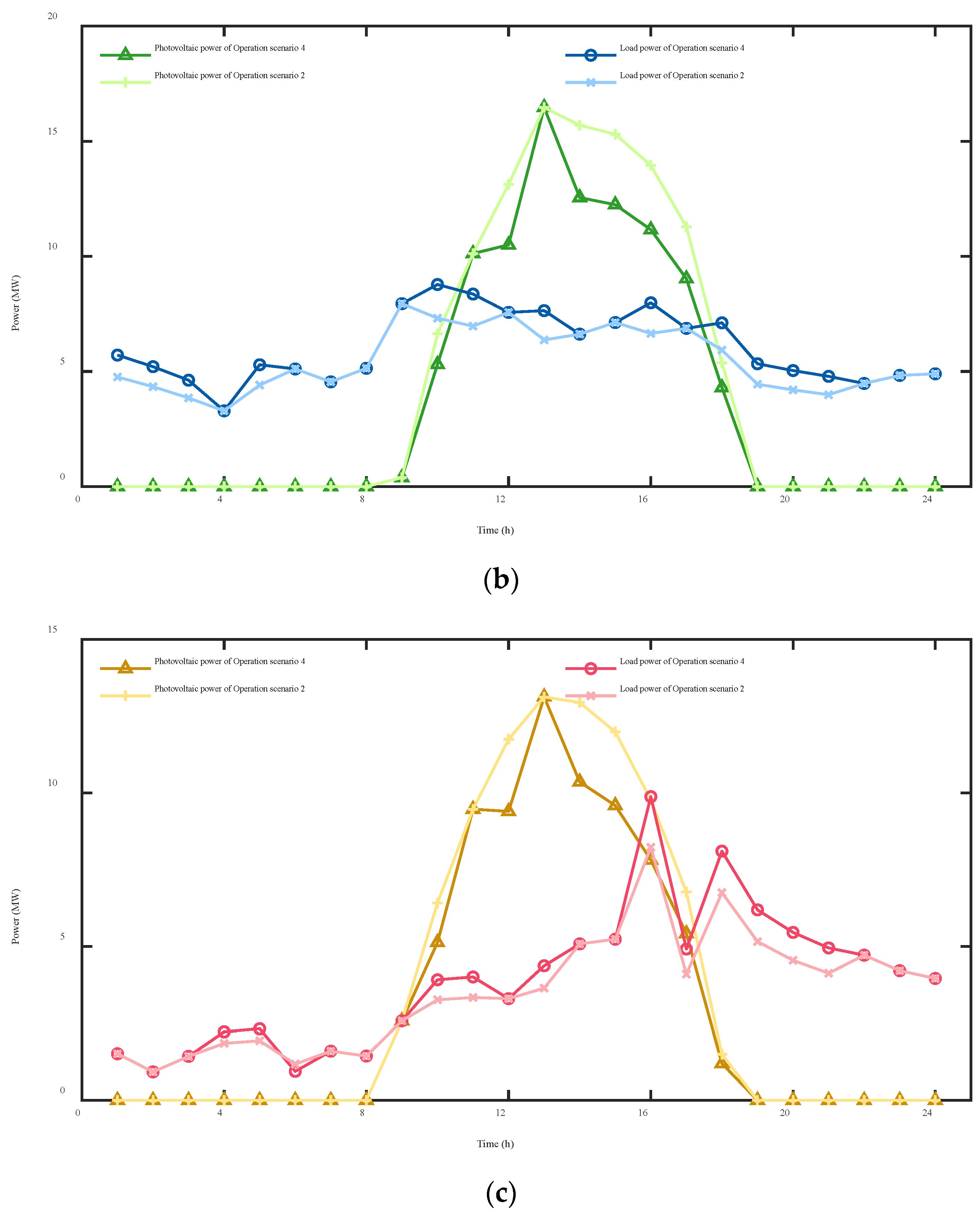
References
- Yang, Y.D.; Wei, B.R.; Qin, Z.J. Sequence-based differential evolution for solving economic dispatch considering virtual power plant. IET Gener. Transm. Distrib. 2019, 13, 3202–3215. [Google Scholar] [CrossRef]
- Rosato, A.; Panella, M.; Araneo, R.; Andreotti, A. A neural network based prediction system of distributed generation for the management of microgrids. IEEE Trans. Ind. Appl. 2019, 55, 7092–7102. [Google Scholar] [CrossRef]
- Sreenivasulu, G.; Balakrishna, P. Optimal dispatch of renewable and virtual power plants in smart grid environment through bilateral transactions. Electr. Power Compon. Syst. 2021, 49, 488–503. [Google Scholar] [CrossRef]
- Luo, F.J.; Dorri, A.; Ranzi, G.; Zhao, J.; Jurdak, R. Aggregating buildings as a virtual power plant: Architectural design, supporting technologies, and case studies. IET Energy Syst. Integr. 2022, 4, 423–435. [Google Scholar] [CrossRef]
- Chen, J.R.; Liu, M.Y.; Milano, F. Aggregated model of virtual power plants for transient frequency and voltage stability analysis. IEEE Trans. Power Syst. 2021, 36, 4366–4375. [Google Scholar] [CrossRef]
- Wang, H.; Riaz, S.; Mancarella, P. Integrated techno-economic modeling, flexibility analysis, and business case assessment of an urban virtual power plant with multi-market co-optimization. Appl. Energy 2020, 259, 114142. [Google Scholar] [CrossRef]
- Tan, Z.F.; Wang, S.Y.; Zhong, H.W.; Xia, Q.; Kang, C.Q. Enlarging flexibility region of virtual power plant via dynamic line rating. IET Renew. Power Gener. 2022, 16, 751–760. [Google Scholar] [CrossRef]
- Kuang, Y.; Wang, X.L.; Zhao, H.Y.; Qian, T.; Li, N.L.; Wang, J.X.; Wang, X.F. Model-free demand response scheduling strategy for virtual power plants considering risk attitude of consumers. CSEE J. Power Energy Syst. 2023, 9, 516–528. [Google Scholar] [CrossRef]
- Gough, M.; Santos, S.F.; Lotfi, M.; Javadi, M.S.; Osorio, G.J.; Ashraf, P.; Castro, R.; Catalao, J.P.S. Operation of a technical virtual power plant considering diverse distributed energy resources. IEEE Trans. Ind. Appl. 2022, 58, 2547–2558. [Google Scholar] [CrossRef]
- Wang, N.; Kong, X.Y.; Li, G.Q.; Li, X.F.; Li, X.F.; Li, Z.H. Dynamic aggregation response strategy of adjustable resources of virtual power plants in power grid balance adjustment scenario. In Proceedings of the 25th International Conference on Electrical Machines and Systems (ICEMS), Rajamangala Univ Technol Lanna, Chiang Mai, Thailand, 29 November–2 December 2022; IEEE: New York, NY, USA. [Google Scholar] [CrossRef]
- Panda, S.; Mohanty, S.; Rout, P.K.; Sahu, B.K. A conceptual review on transformation of micro-grid to virtual power plant: Issues, modeling, solutions, and future prospects. Int. J. Energy Res. 2022, 46, 7021–7054. [Google Scholar] [CrossRef]
- Naughton, J.; Wang, H.; Riaz, S.; Cantoni, M.; Mancarella, P. Optimization of multi-energy virtual power plants for providing multiple market and local network services. Electr. Power Syst. Res. 2020, 189, 106775. [Google Scholar] [CrossRef]
- Liu, X.O. Research on the evaluation method and system development of emergency regulation capacity for multiple virtual power plants. Int. J. Electr. Power Energy Syst. 2023, 153, 109318. [Google Scholar] [CrossRef]
- Chang, W.G.; Yang, Q. Low carbon oriented collaborative energy management framework for multi-microgrid aggregated virtual power plant considering electricity trading. Appl. Energy 2023, 351, 121906. [Google Scholar] [CrossRef]
- Gougheri, S.S.; Dehghani, M.; Nikoofard, A.; Jahangir, H.; Golkar, M.A. Economic assessment of multi-operator virtual power plants in electricity market: A game theory-based approach. Sustain. Energy Technol. Assess. 2022, 53, 102733. [Google Scholar] [CrossRef]
- Chu, T.F.; An, X.C.; Zhu, Y.; Wang, X.Y.; Deng, L.M. Multiple game trading strategy of multiple virtual power plants considering carbon trading. Front. Energy Res. 2023, 11, 1152032. [Google Scholar] [CrossRef]
- Liu, W.; Xu, H.; Wang, X.C.; Zhang, S.C.; Hu, T.H. Optimal dispatch strategy of virtual power plants using potential game theory. Energy Rep. 2022, 8, 1069–1079. [Google Scholar] [CrossRef]
- Gao, H.J.; Zhang, F.; Xiang, Y.M.; Ye, S.Y.; Liu, X.A.; Liu, J.Y. Bounded rationality based multi-vpp trading in local energy markets: A dynamic game approach with different trading targets. CSEE J. Power Energy Syst. 2023, 9, 221–234. [Google Scholar] [CrossRef]
- Chen, W.X.L.; Xiang, Y.; Liu, J.Y. Optimal operation of virtual power plants with shared energy storage. IET Smart Grid 2023, 6, 147–157. [Google Scholar] [CrossRef]
- Wan, X.M.; Wen, X.; Tang, B.H.; Sun, Q.F. Trading strategy for virtual power plant clusters based on a multi-subject game model. J. Comput. Methods Sci. Eng. 2023, 23, 2261–2274. [Google Scholar] [CrossRef]
- Pan, J.; Liu, X.O.; Huang, J.J. Multi-level games optimal scheduling strategy of multiple virtual power plants considering carbon emission flow and carbon trade. Electr. Power Syst. Res. 2023, 223, 109669. [Google Scholar] [CrossRef]
- Liu, X.; Li, S.A.; Zhu, J.G. Optimal coordination for multiple network-constrained vpps via multi-agent deep reinforcement learning. IEEE Trans. Smart Grid 2023, 14, 3016–3031. [Google Scholar] [CrossRef]
- Castillo, A.; Flicker, J.; Hansen, C.W.; Watson, J.P.; Johnson, J. Stochastic optimisation with risk aversion for virtual power plant operations: A rolling horizon control. IET Gener. Transm. Distrib. 2019, 13, 2063–2076. [Google Scholar] [CrossRef]
- Song, J.Q.; Yang, Y.B.; Xu, Q.S. Two-stage robust optimal scheduling method for virtual power plants considering the controllability of electric vehicles. Electr. Power Syst. Res. 2023, 225, 109785. [Google Scholar] [CrossRef]
- Yuanyuan, Z.; Huiru, Z.; Bingkang, L. Distributionally robust comprehensive declaration strategy of virtual power plant participating in the power market considering flexible ramping product and uncertainties. Appl. Energy 2023, 343, 121133. [Google Scholar] [CrossRef]
- Yu, J.; Feng, Q.Z.; Li, Y.; Cao, J.D. Stochastic optimal dispatch of virtual power plant considering correlation of distributed generations. Math. Probl. Eng. 2015, 2015, 135673. [Google Scholar] [CrossRef]
- Song, C.N.; Jing, X.P. Bidding strategy for virtual power plants with the day-ahead and balancing markets using distributionally robust optimization approach. Energy Rep. 2023, 9, 637–644. [Google Scholar] [CrossRef]
- Huy, N.D.; Nhung, N.H. A study on the bidding strategy of the virtual power plant in energy and reserve market. Energy Rep. 2020, 6, 622–626. [Google Scholar] [CrossRef]
- Sowa, T.; Vasconcelos, M.; Schnettler, A.; Metzger, M.; Hammer, A.; Reischboek, M.; Köberle, R. Method for the operation planning of virtual power plants considering forecasting errors of distributed energy resources. Electr. Eng. 2016, 98, 347–354. [Google Scholar] [CrossRef]
- Fan, Q.; Liu, D. A wasserstein-distance-based distributionally robust chance constrained bidding model for virtual power plant considering electricity-carbon trading. IET Renew. Power Gener. 2023, 283, 116285. [Google Scholar] [CrossRef]
- Chen, Y.; Niu, Y.G.; Du, M.; Wang, J.H. A two-stage robust optimization model for a virtual power plant considering responsiveness-based electric vehicle aggregation. J. Clean Prod. 2023, 405, 136690. [Google Scholar] [CrossRef]
- Emarati, M.; Keynia, F.; Rashidinejad, M. A two-stage stochastic programming framework for risk-based day-ahead operation of a virtual power plant. Int. Trans. Electr. Energy Syst. 2020, 30, 12255. [Google Scholar] [CrossRef]
- Zhao, C.Y.; Wang, J.H.; Watson, J.P.; Guan, Y.P. Multi-stage robust unit commitment considering wind and demand response uncertainties. IEEE Trans. Power Syst. 2013, 28, 2708–2717. [Google Scholar] [CrossRef]
- Cui, S.C.; Wang, Y.W.; Xiao, J.W. Peer-to-peer energy sharing among smart energy buildings by distributed transaction. IEEE Trans. Smart Grid 2019, 10, 6491–6501. [Google Scholar] [CrossRef]
- Han, B.; Shang, C.; Huang, D.X. Multiple kernel learning-aided robust optimization: Learning algorithm, computational tractability, and usage in multi-stage decision-making. Eur. J. Oper. Res. 2021, 292, 1004–1018. [Google Scholar] [CrossRef]
- Zeng, B.; Zhao, L. Solving two-stage robust optimization problems using a column-and-constraint generation method. Oper. Res. Lett. 2013, 41, 457–461. [Google Scholar] [CrossRef]
- Zhou, Q.; Zhang, J.M.; Gao, P.F.; Zhang, R.X.; Liu, L.J.; Wang, S.; Cheng, L.; Wang, W.; Yang, S.Y. Two-stage robust optimization for prosumers considering uncertainties from sustainable energy of wind power generation and load demand based on nested c&cg algorithm. Sustainability 2023, 15, 9769. [Google Scholar] [CrossRef]
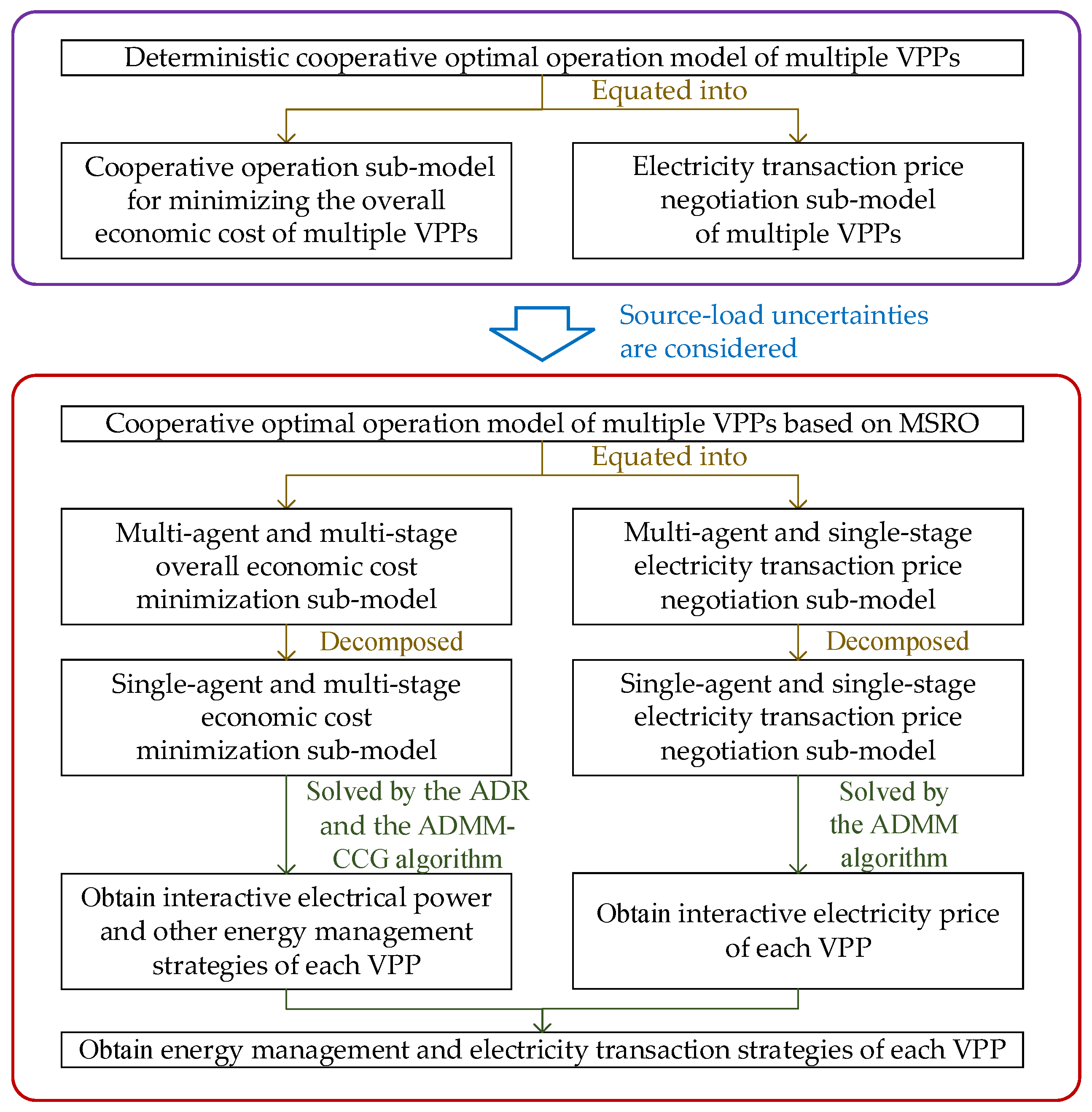
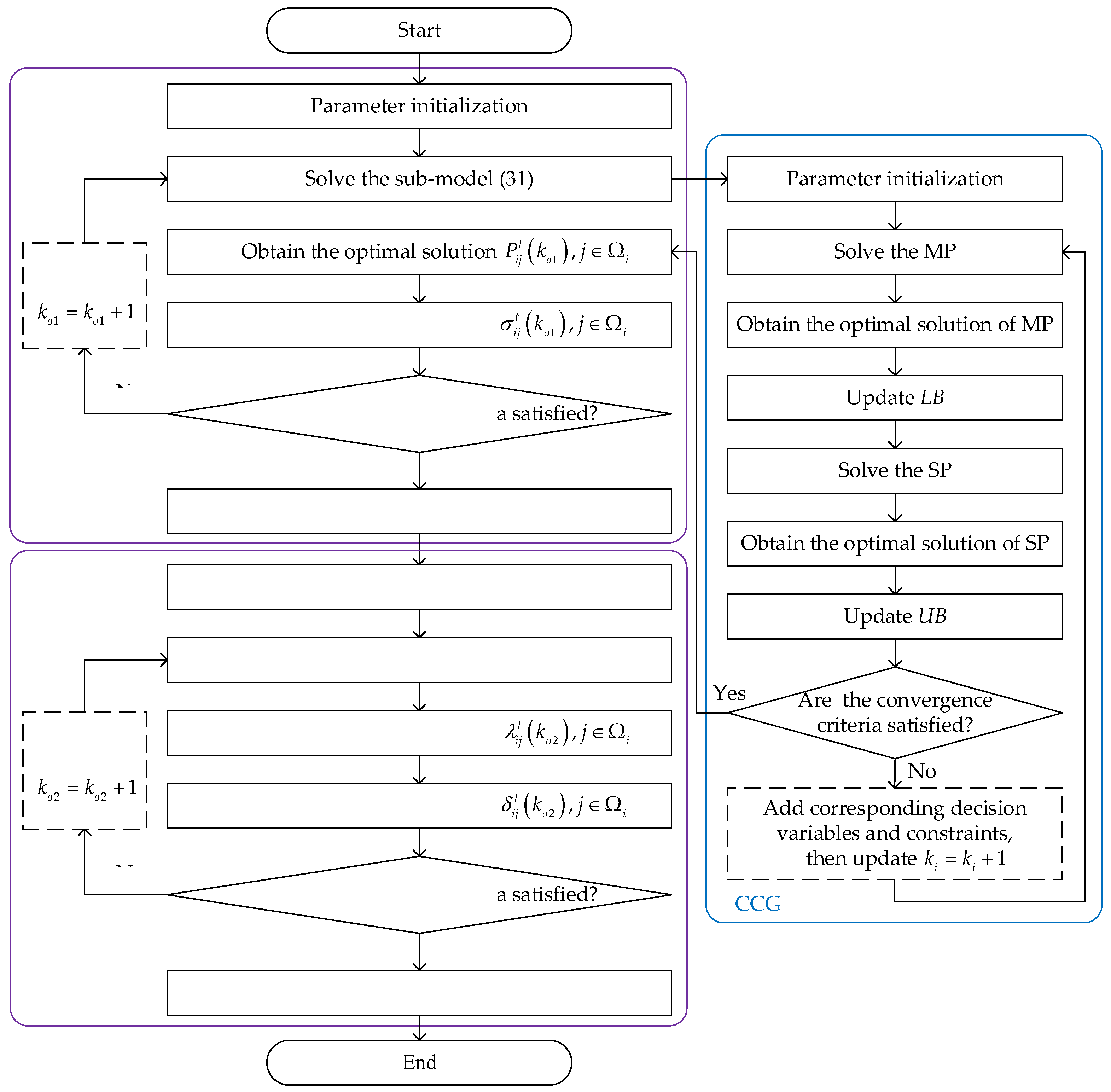
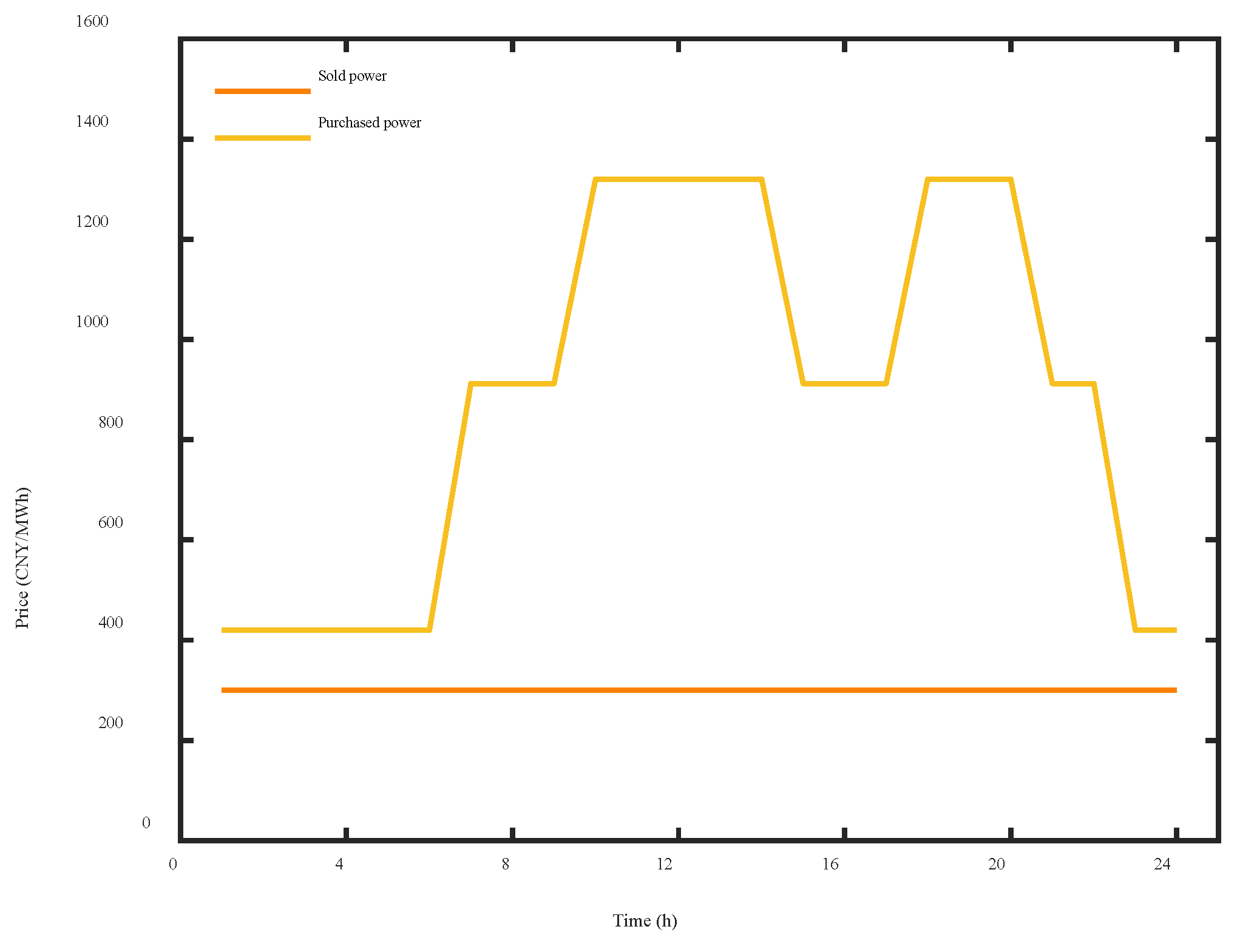
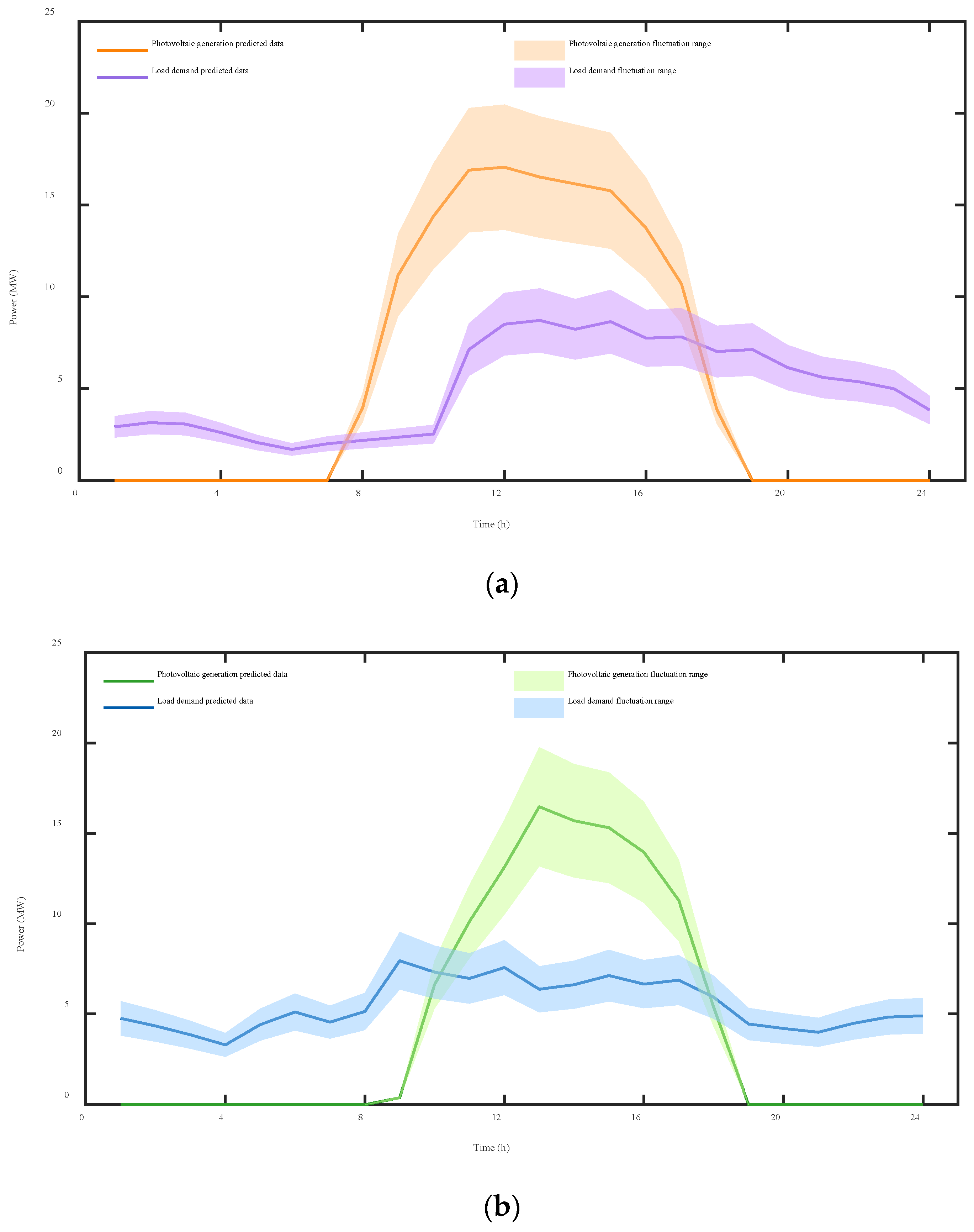
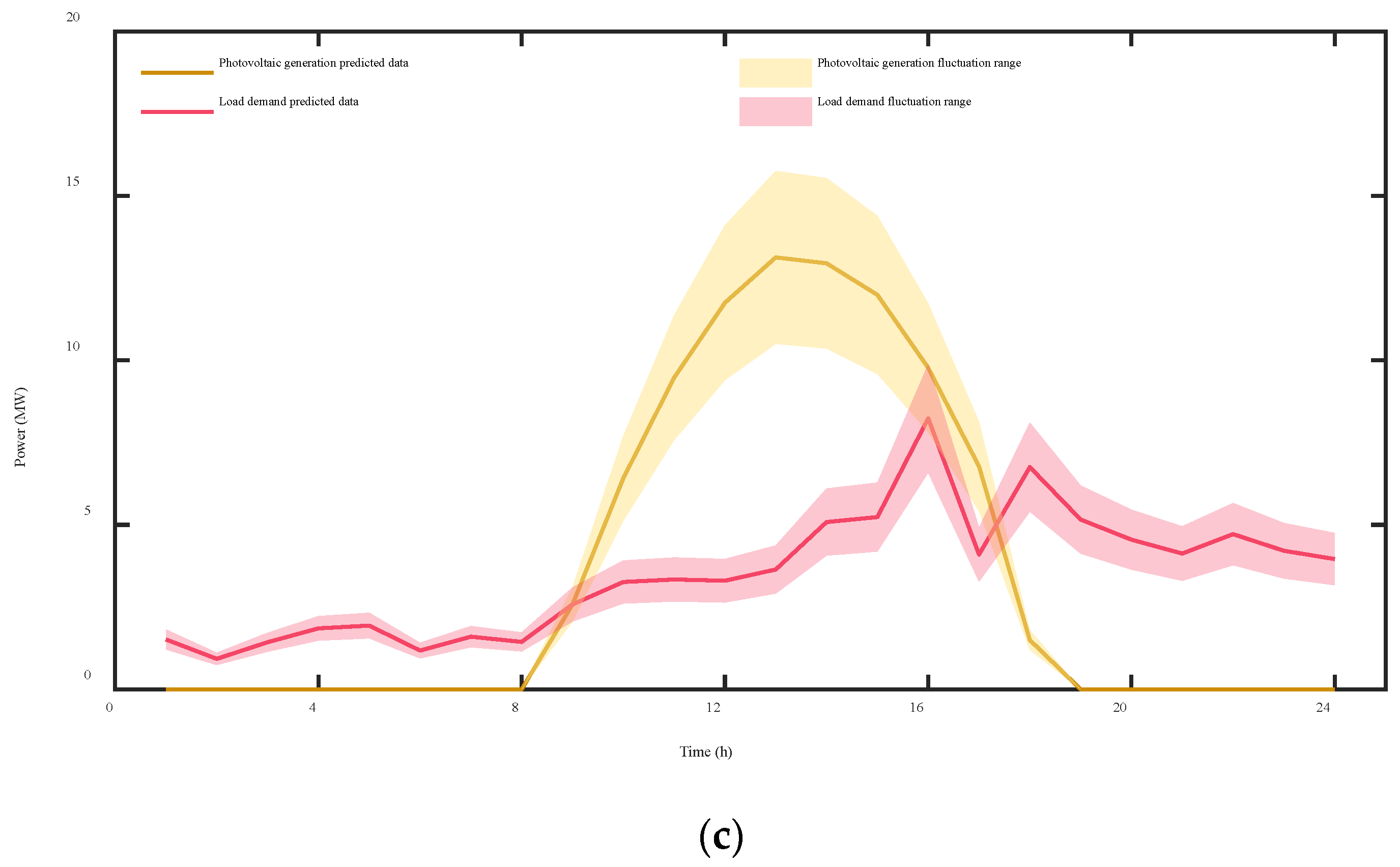

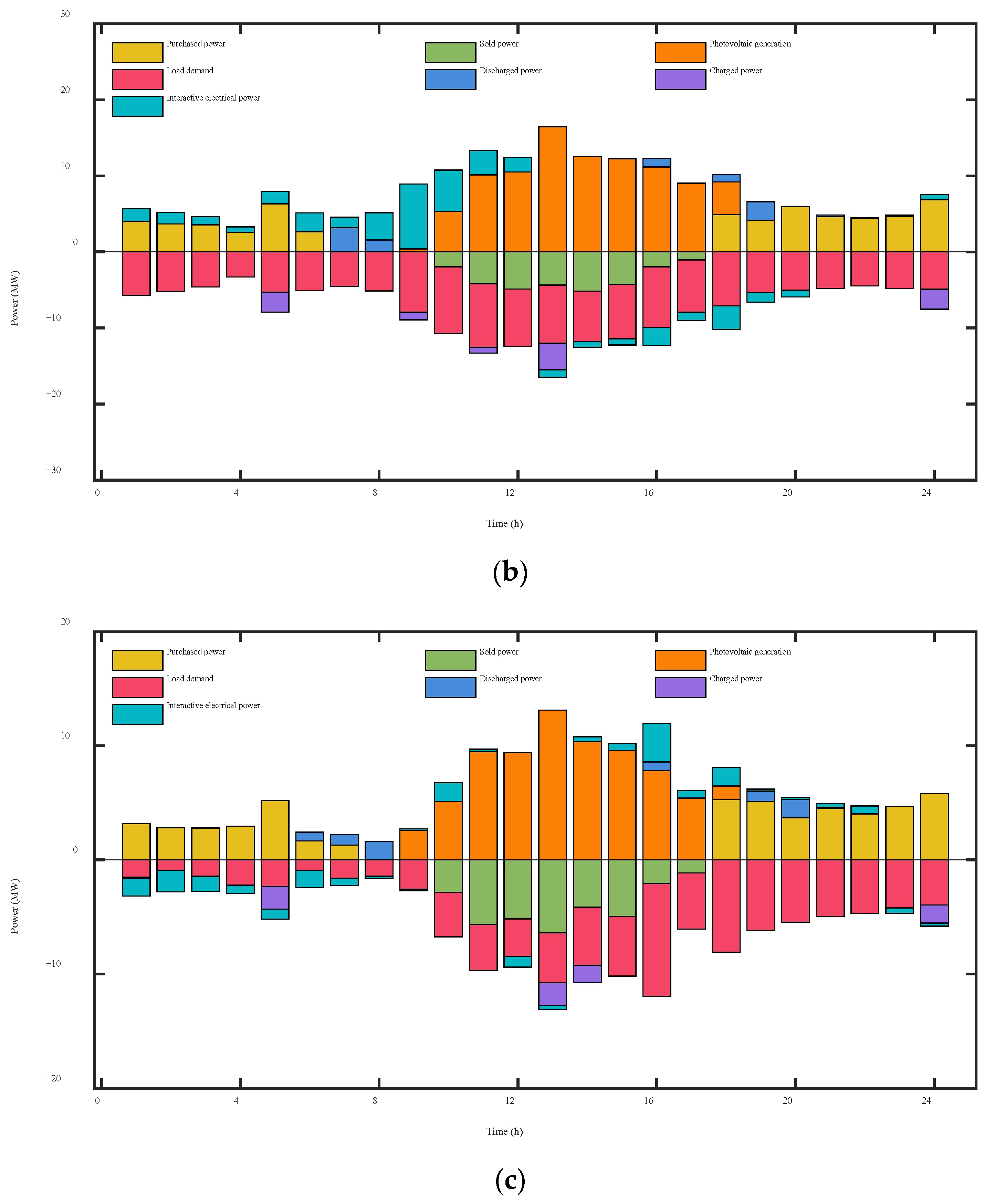
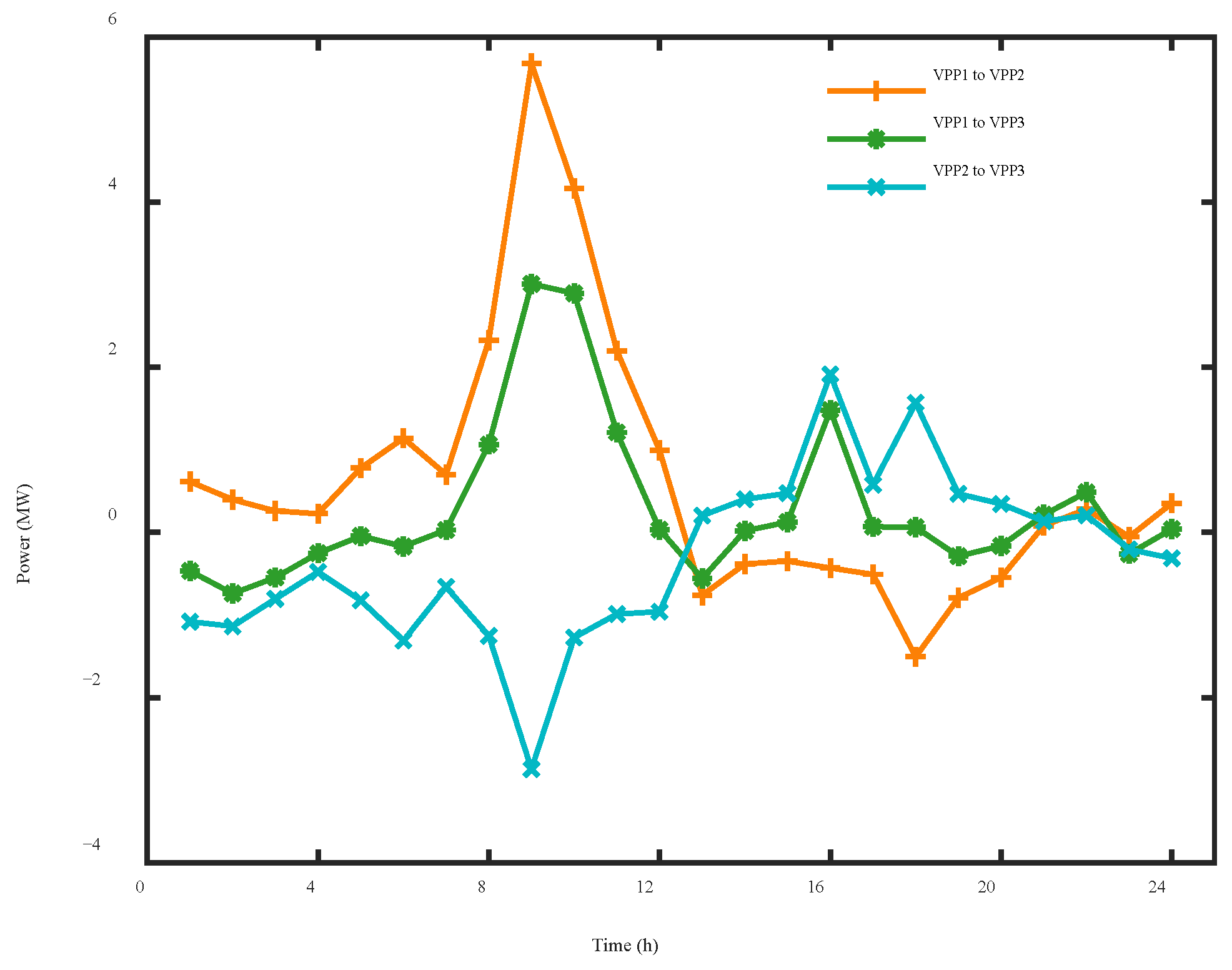
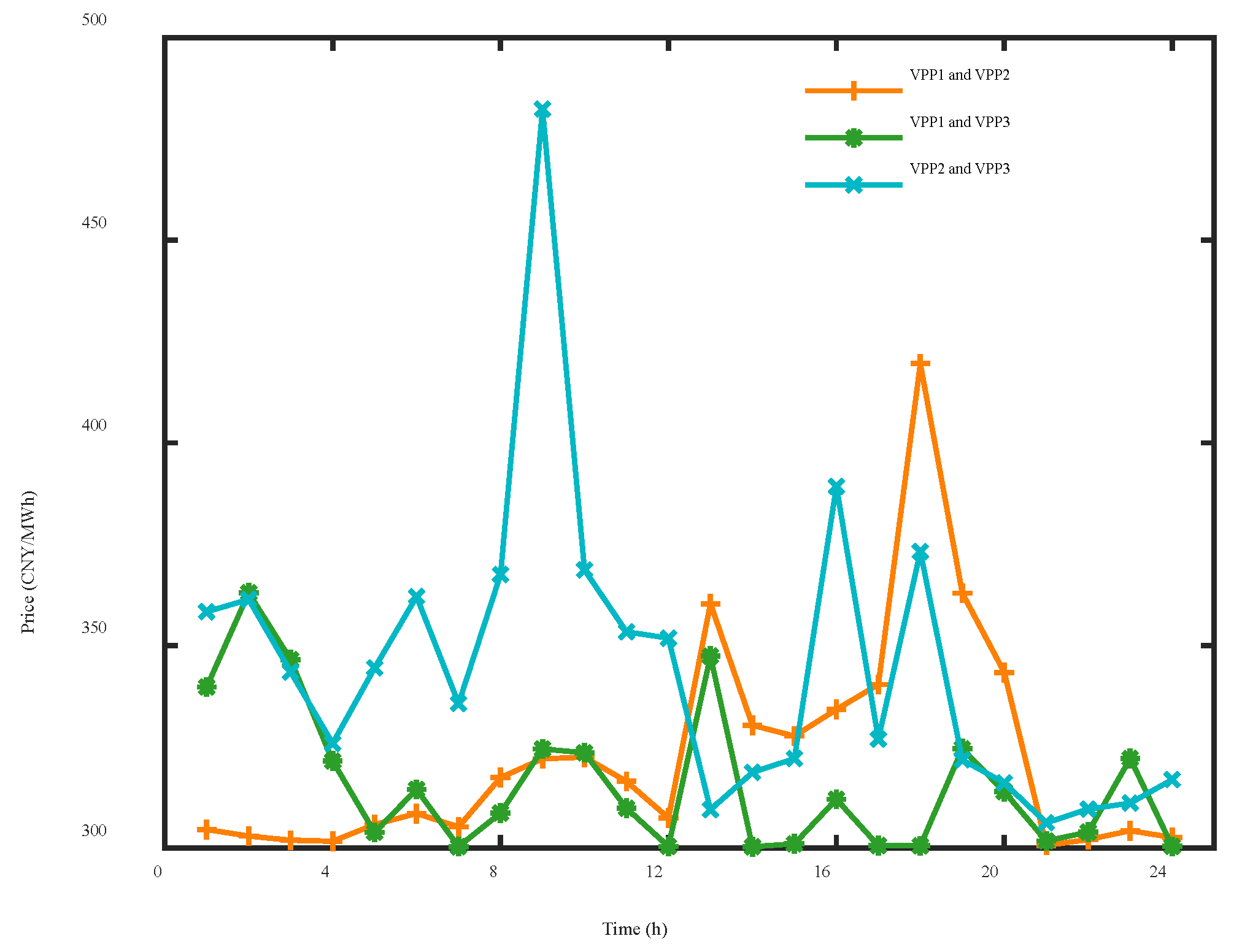
| Parameters | VPP1 | VPP2 | VPP3 |
|---|---|---|---|
| Charging/discharging cost coefficient (CNY/MW) | 50 | 50 | 50 |
| Maximum charging/discharging power (MW) | 2.5/2.5 | 3.5/3.5 | 2.0/2.0 |
| Maximum/minimum capacity (MWh) | 4.5/0.5 | 6.0/1.0 | 4.0/0.5 |
| Charging/discharging efficiency | 0.95/0.95 | 0.95/0.95 | 0.95/0.95 |
| Operation Scenarios | Operation Cost of VPP1 (CNY) | Operation Cost of VPP2 (CNY) | Operation Cost of VPP3 (CNY) | Operation Cost in Total (CNY) |
| 1 | 17,975.967 | 30,979.636 | 19,956.358 | 68,911.961 |
| 2 | 15,625.788 | 28,814.345 | 17,629.428 | 62,069.561 |
| 3 | 33,893.725 | 43,554.268 | 30,745.384 | 108,193.377 |
| 4 | 32,960.067 | 42,697.333 | 29,818.899 | 105,476.299 |
| 5 | 32,847.646 | 42,549.012 | 29,713.478 | 105,110.136 |
| Optimization Model | Convergence Accuracy | Iteration Times to Converge | Computing Time (s) |
|---|---|---|---|
| Sub-model (31) | Original residual of ADMM: 10−5 Dual residual of ADMM: 10−5 Convergence residual of CCG: 10−3 | 216 | 638.49 |
| Sub-model (35) | Original residual of ADMM: 10−8 Dual residual of ADMM: 10−8 | 44 | 87.35 |
| Optimization Model | Computing Time (s) |
|---|---|
| Sub-model (31) | 12.05 |
| Sub-model (35) | 3.66 |
Disclaimer/Publisher’s Note: The statements, opinions and data contained in all publications are solely those of the individual author(s) and contributor(s) and not of MDPI and/or the editor(s). MDPI and/or the editor(s) disclaim responsibility for any injury to people or property resulting from any ideas, methods, instructions or products referred to in the content. |
© 2024 by the authors. Licensee MDPI, Basel, Switzerland. This article is an open access article distributed under the terms and conditions of the Creative Commons Attribution (CC BY) license (https://creativecommons.org/licenses/by/4.0/).
Share and Cite
Cheng, L.; Li, Y.; Yang, S. Distributed Cooperative Optimal Operation of Multiple Virtual Power Plants Based on Multi-Stage Robust Optimization. Sustainability 2024, 16, 5301. https://doi.org/10.3390/su16135301
Cheng L, Li Y, Yang S. Distributed Cooperative Optimal Operation of Multiple Virtual Power Plants Based on Multi-Stage Robust Optimization. Sustainability. 2024; 16(13):5301. https://doi.org/10.3390/su16135301
Chicago/Turabian StyleCheng, Lin, Yuling Li, and Shiyou Yang. 2024. "Distributed Cooperative Optimal Operation of Multiple Virtual Power Plants Based on Multi-Stage Robust Optimization" Sustainability 16, no. 13: 5301. https://doi.org/10.3390/su16135301
APA StyleCheng, L., Li, Y., & Yang, S. (2024). Distributed Cooperative Optimal Operation of Multiple Virtual Power Plants Based on Multi-Stage Robust Optimization. Sustainability, 16(13), 5301. https://doi.org/10.3390/su16135301






